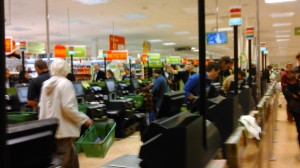Technology, who wants it more?
 Right now technology is sitting in the majority of retailers’ priority lists when it comes to meeting with predicted shopper expectations around store design.
Right now technology is sitting in the majority of retailers’ priority lists when it comes to meeting with predicted shopper expectations around store design.
In particular, retailers have got their eye on mobile point of sale, as well as queue management and ordering kiosks as a means to provide a choice of multi-channel options and in turn better service. Digital screens to support product information and shelf edge pricing are also seen to be making an impact on customers.
According to Retail Week’s Shop Report 2014 the majority of today’s consumers do recognise these technologies as a familiar part of their shopping experience. However, it is not so clear whether they are really in demand for them as over a third of consumers aren’t familiar with any such technology based shopping experiences and almost a third say they aren’t particularly important to them when shopping anyway. It has been noted however that when technology is present in store customers are reacting positively to it. Argos and Currys PC World are two good examples of this as both are favoured highly by customers for their use of technology in store.
Over in the US Macy’s department store is pushing technology in a bid to be seen as a relevant brand. Point of purchase kiosks that can be used by customers to access more product information, check out reviews and pay for their items are under testing, as well as a digital catalogue. Macy’s is also offering its in store brand partners the opportunity to offer customers interactive experiences. Calvin Klein in particular has used interactive touch screens and virtual sales assistants to enhance the shopping experience.
Meanwhile, newer technologies like virtual fitting rooms, internet-connected clothing and augmented reality mirrors are currently still finding their place among both retailers and consumers. The time may not be right now for these shopping tools, but is considered by some in the industry to be just a few years away. This isn’t to say some retailers aren’t playing around with the idea. Bloomingdale’s also in the US for instance appears to be embracing the latest technologies and has opened a new high tech department store designed to target consumers that are keen to shop using technology. Smart dressing rooms will feature a number of digital devices including: wall-mounted tablets to provide customers with additional product information and reviews, mirrors with lighting controls as well as interactive touch screens that can be used to call for staff assistance. In addition, shop assistants are armed with mobile tablets to help serve customers. Going one step further, US home improvement store Lowes is using robots to boost service and free up staff members to better serve customers. The robots can check on product stock levels and find the location of items in store. Shoppers can ask them for help by voice or touch screen.
For those consumers that are already technology confident however, retailers may need to up their imagination to get them shopping in store rather the online. A recent report by Samsung argues that retailers need to make better use of technology in order to excite and capture the younger consumer who is ready for hi-tech shopping. Graham Long, Samsungs’s UK and Ireland Vice President of its enterprise business team, explained: “Retailers need to be using technology to create a sense of retail theatre and bring their physical environment to life; they need to enhance the shopping experience”. A few of Samsung’s more innovative shopping solutions include: a 3G smart watch to be used by staff for product information and task management, a virtual reality headset for virtual store planning, and a 95” touch screen to showcase unlimited stock that is life size.
Thomson, holiday operator, was praised this year for its theatrical digital design that really brought holidays to life in store and won digital store of the year at the BT Retail Week Technology Awards 2014. Its features included: an exterior immersive wall to get passers by in the holiday mood, digital billboards in the store entrance that showcase the Thomson holiday products, an interactive map that allowed customers to explore the world and resorts and properties, touch screens for holiday searching, self service PCs that could be used by customers to print e-tickets, check trip advisor and make bookings, and personalised projection walls that customers could view tailored holiday content on. Doug Glenwright, Thomson’s general manager of retail transformation said the aim of the digital revamp was to make buying holidays as exciting as possible: “To do this we needed to bring our products to life in an engaging and inspiring way, and put the customer in control of their in store experience, allowing them to get as close to our products as possible and personalising their experience to make it memorable”. Next on Thomson’s digital agenda is mobile which it sees as a route to get the brand and its products into people’s hands in an even more sophisticated and exciting way.
3 tips Thomson’s shared to make digital technology work in store are:
- Put the customer in control by using technology that lets them lead the communication; touch screens invite interaction.
- Make sure the technology is integrated seamlessly and is simple to use, and encourage staff to join in and promote the service when necessary.
- Stay relevant. Make personalised services intuitive and beneficial for the customer, rather than a route to presumptive selling.
In all, it could be argued that retailers are simply recognising the convenient benefits surrounding in store technology before some, but not all, consumers, and that therefore they are right to implement it into their retail strategy. The younger generation is ready to go, and for those consumers that are quite there yet, familiarity will go on to create demand.


No comments yet.